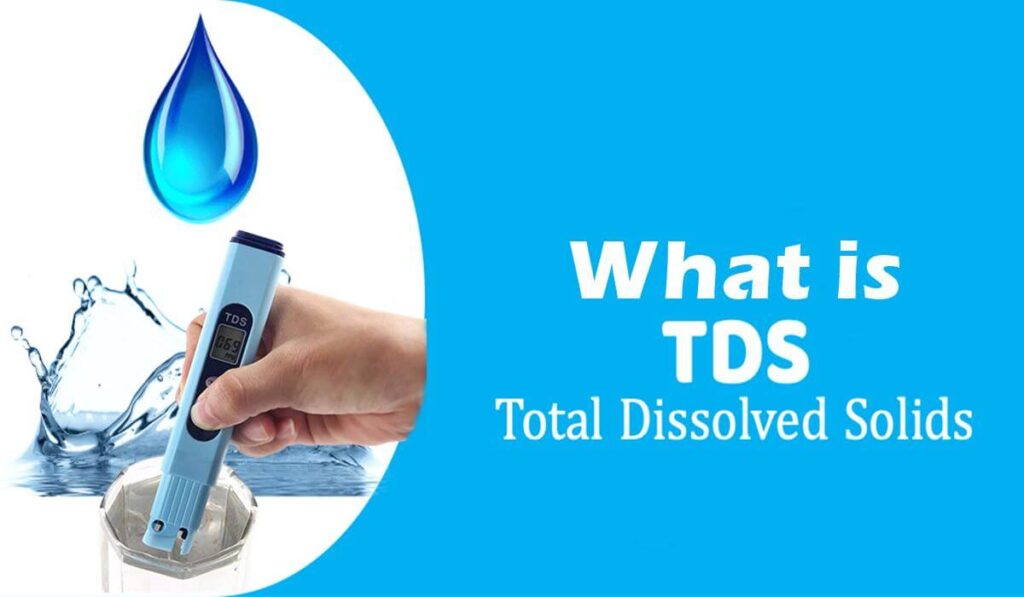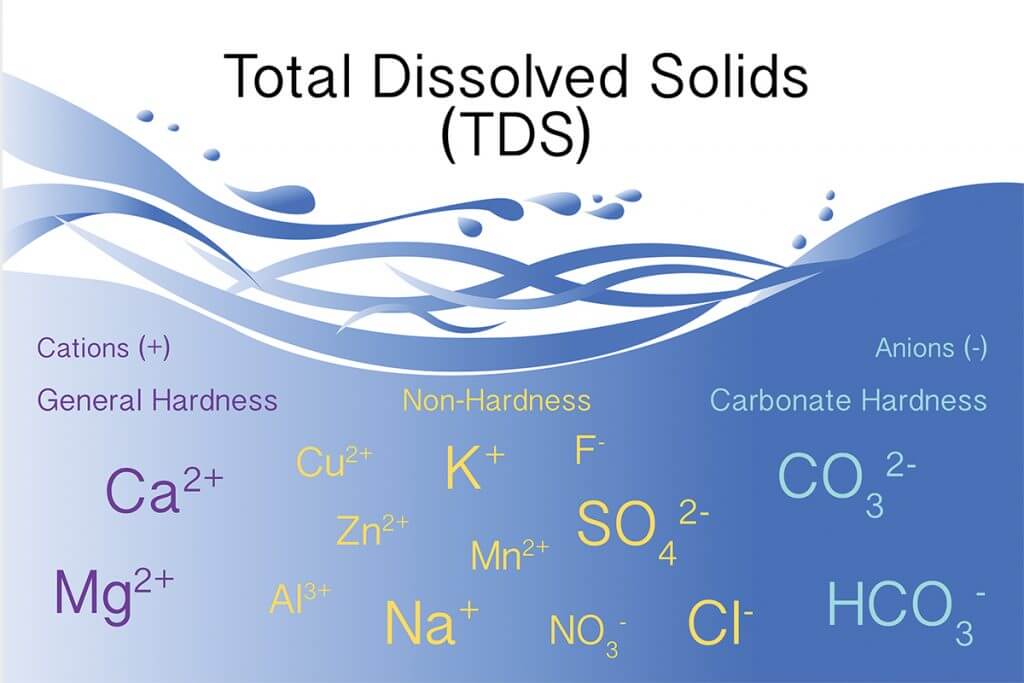Water’s remarkable capability as a universal solvent stems from its proficiency in dissolving and absorbing molecules from diverse materials. This trait is quantified by the measure known as Total Dissolved Solids (TDS), which indicates the concentration of particles, both organic and inorganic, in a given volume of water. Gaining insights into the TDS level of your water, along with the specific types of dissolved solids it contains, offers a comprehensive overview of your water’s quality. In the following sections, we will delve into the various categories of total dissolved solids, explore methods for their measurement, and discuss strategies to effectively reduce the TDS levels in your water.

What is the TDS in water?
Total Dissolved Solids (TDS) encompass the collective presence of both organic and inorganic substances, such as minerals, salts, metals, and ions, dispersed in a specific volume of water. Essentially, TDS represents all elements dissolved in water apart from the water molecules themselves. As a natural solvent, water has the ability to integrate particles from soluble materials it encounters, thus forming total dissolved solids. The sources of TDS in water are varied and widespread, ranging from natural origins like springs to man-made contributors such as municipal water treatment chemicals, environmental runoff from roads and landscapes, and even the pipes within your own household plumbing system.
Types of total dissolved solids
The following list details common total dissolved solids that may be present in your water.
| Column 1 | Column 2 |
|---|---|
| Calcium | Arsenic |
| Chloride | Iron |
| Magnesium | Chlorine |
| Potassium | Sodium |
| Zinc | Fluoride |
| Aluminum | Bicarbonates |
| Copper | Sulfates |
| Lead | Pesticides |
| Herbicides |
Testing your water with a TDS meter is the quickest and most convenient way to measure the water’s TDS level. Since salts, minerals, and other dissolved ionized solids increase the conductivity of a liquid, a TDS meter measures the solution’s electrical conductivity then uses that reading to estimate the TDS.
Sources of total dissolved solids
Total Dissolved Solids (TDS) originate from a variety of both natural and anthropogenic sources. Nature contributes to TDS levels through elements like springs, lakes, rivers, vegetation, and the soil. For instance, natural springs, as they traverse underground, assimilate minerals like calcium, magnesium, and potassium from the surrounding rocks.

Conversely, human activities also contribute to the presence of TDS in water. Agricultural activities can introduce pesticides and herbicides through runoff, while older plumbing systems might leach lead into the water. Similarly, chlorine often finds its way into water due to processes at water treatment facilities. Additionally, TDS are sometimes intentionally added to bottled water, evident in the mineral-enhanced varieties available in stores.
What is a good or bad TDS level for water?
The presence of Total Dissolved Solids (TDS) in water is generally not considered a health hazard, which is why the Environmental Protection Agency (EPA) has not set a strict limit for TDS content. Nonetheless, the EPA does recommend that the TDS level in drinking water should not exceed 500 parts per million (ppm). Exceeding this suggested threshold can lead to noticeable changes in the water, such as visible deposits, a heavier or saltier taste, staining, and other alterations.

To better understand the implications of different TDS levels, we will present a TDS water chart that categorizes various levels of TDS in water and their corresponding evaluations.
| Level of TDS (mg/L) | Rating |
| Less than 50 | Considered low: Missing some vital, healthy minerals |
| 50 – 300 | Excellent: The perfect level for TDS in drinking water |
| 300 – 500 | Good: The sweet spot for TDS in drinking water |
| 600 – 900 | Fair: Consider a reverse osmosis system to remove your TDS |
| 900 – 1200 | Poor: Not recommended or safe for use |
| Above 1200 | Unacceptable: Completely unsafe and possibly too much to handle for household filters |
My tap water has an excellent TDS level. Does that mean it is safe to drink?
Having a low TDS level in your tap water does not automatically guarantee its safety for drinking. TDS, or Total Dissolved Solids, measures only the charged particles in water. This metric overlooks uncharged contaminants like pesticides, gasoline, motor oil, and pharmaceuticals, which do not contribute to TDS levels. Additionally, common TDS meters are incapable of detecting PFAS compounds in water. Consequently, a low TDS reading might lead to a false sense of security regarding water purity, while the water could still be laden with harmful toxins.
It’s also important to recognize that even though some toxic substances become charged when dissolved in water, TDS meters do not provide detailed insights into the presence and concentration of these contaminants. This limitation arises because:

- TDS testers lack the sensitivity to identify and quantify toxic concentrations of arsenic, lead, chromium-6, and other hazardous pollutants. Standard TDS meters measure in parts per million, but contaminants like lead, arsenic, and chromium-6 can be harmful in parts per billion – a concentration a thousand times lower.
- TDS meters cannot distinguish between different types of ions. They are non-selective, meaning that more sophisticated technology is required to accurately measure certain water contaminants.
It’s crucial to understand that TDS meters are not reliable for detecting specific harmful substances like lead and arsenic. Advanced testing equipment is necessary for accurate assessments. The TDS level of a water sample might be low, even when harmful contaminants like lead exceed EPA limits by significant margins. Therefore, relying solely on TDS measurements to determine water quality can be misleading, and it’s essential to conduct more thorough testing to truly assess the safety of your water.
How is TDS measured?
Total Dissolved Solids (TDS) in water are quantified in milligrams per liter (mg/L), which is equivalent to parts per million (ppm). The Environmental Protection Agency (EPA) recommends that drinking water should contain no more than 500 ppm of TDS, as per its secondary drinking water guidelines. A TDS level above 1000 ppm is considered unsafe, and if TDS exceeds 2000 ppm, it may challenge the effectiveness of standard filtration systems.

To measure TDS, a TDS meter is commonly used. For instance, a reading of 100 ppm on a TDS meter means there are 100 dissolved ion particles per million particles in the water, with the rest being water molecules. This is typically classified as a low TDS level. However, it’s important to note that a TDS meter doesn’t specify the types of dissolved solids, which is crucial information for assessing water quality. Therefore, to identify the specific types of TDS present, using a home water testing kit or seeking a laboratory water analysis is advisable. Additionally, water suppliers conduct regular water quality tests and can provide these reports upon request, offering further insights into your water’s TDS composition.
How to measure TDS?
If you have a reverse osmosis system, you can use the following formula to calculate the percent rejection of TDS and to measure your RO system’s performance.
- Measure the TDS of raw feed water by submersing the tester’s probes into a glass of tap water. Record the results.
- Measure the TDS of your RO water by filling a glass with RO water (from RO faucet) and submersing the tester’s probes into the water. Record the results.
- Calculate percent rejection using the following formula:

Example: Tap TDS = 260 ppm RO TDS = 20 ppm Rejection = [(260 – 20) / 260] x 100 = [240/260] x 100 ≈ (.923) x 100 = 92.3
Note: If your RO system is new or the membrane has been replaced, do not test the first tank of RO water. The first tank will contain sanitizer and possibly carbon fines from your new filters that will cause a false reading.
Why should you measure total dissolved solids?
Measuring Total Dissolved Solids (TDS) is essential as it influences various aspects of daily life, including the quality of your water, health implications, the integrity of your home plumbing systems, and routine activities like cooking and cleaning. By determining the TDS levels in your water, you gain valuable insights into the overall water quality and its impact on your daily routines. This knowledge empowers you to make educated decisions about addressing any water quality issues and choosing the most suitable water filtration system for your household needs.

- Taste and Odor Water with elevated Total Dissolved Solids (TDS) levels often exhibits a distinct bitter taste and an off-putting odor. As the TDS concentration increases, so does the bitterness of the water. To enhance the taste and smell of such tap water, using a reverse osmosis system or a ceramic water filter is advisable.
- Health Considerations While high TDS in water doesn’t automatically equate to health risks, certain dissolved substances like lead and copper pose significant hazards. Lead can adversely affect the brain and nervous system, while excessive copper intake might lead to nausea. To remove these heavy metals, employing a reverse osmosis system or a water distiller is recommended.
- Filter System Upkeep Employing water filtration systems is an effective way to decrease TDS, but these systems require regular maintenance. Regular TDS testing ensures the filtration system is functioning correctly and signals when maintenance is due.
- Impact on Plumbing and Appliances Hard water, characterized by high levels of dissolved calcium and magnesium, often leads to elevated TDS. These minerals can accumulate in pipes, causing scale buildup and potentially expensive pipe repairs, as well as reducing the lifespan of appliances. Implementing a water softener can help filter out calcium and magnesium, thereby preventing scale formation.
- Impact on Cooking While TDS levels below 1000 ppm are generally not harmful to health, cooking with water that has high TDS can alter the flavor of food. For instance, if the water is rich in chlorine, it could impart an undesirable taste to foods like pasta during boiling. To mitigate this, using a carbon filter proves effective in removing chlorine from the water.
- Cleaning Challenges Persistent water spots on dishes, fading of clothes in the wash, and buildup in sinks can all be signs of high TDS levels in your water. These issues can make cleaning tasks less effective. Employing a water softener or a suitable filtration system can help reduce TDS levels, thereby enhancing the efficiency of your cleaning processes.
Health effects of high TDS in drinking water
While high Total Dissolved Solids (TDS) levels can impact the taste of water, they are typically not harmful to health. Nonetheless, TDS readings over 500 ppm warrant additional scrutiny for potentially toxic elements and heavy metals. A TDS level surpassing 1000 ppm is generally deemed unsafe for consumption. Crucially, the specific types of dissolved solids in the water hold more significance for health than the quantity of TDS. To ascertain if your water contains hazardous substances such as lead, pesticides, or herbicides, using a home water testing kit or conducting a laboratory analysis is recommended.

Is low TDS water harmful?
No, low TDS water is not harmful. A low TDS level actually means you have high-quality water, but it may have a flat taste, as it is devoid of many minerals.
The effect of TDS on plants
In hydroponic gardening, where plants, vegetables, or flowers are grown in water-based solutions, Total Dissolved Solids (TDS) are crucial for nutrient delivery. Potassium and nitrates, common contributors to high TDS levels, are particularly beneficial for plants like roses. For optimal growth, flowers generally require TDS levels between 1000-1100 ppm, whereas vegetables thrive best with TDS levels around 900-1000 ppm. However, it’s vital to identify the specific types of dissolved solids in the water used for irrigation. The presence of toxic ions is a concern as plants can absorb these harmful substances, potentially impacting their growth and safety for consumption.

How to reduce TDS in water?
Reverse Osmosis
Water treatment systems are key solutions for lowering or eliminating Total Dissolved Solids (TDS) in water, particularly when TDS levels exceed 500 ppm. The choice of filtration system largely depends on the specific types of TDS present in the water. Systems like reverse osmosis, water distillers, and deionization units are effective and comprehensive options, capable of reducing a significant portion of the total dissolved solids in water.
Distillation
This kind of water purification system offers clean water through boiling and producing water vapor. When water vapor rises and reaches a cool surface, it will condense back to the liquid form. The dissolved salts and other particles are unable to vaporize thus remain in the boiling solution.
Deionisation (DI)
By definition, deionization (DI) is the removal of all ionized minerals and salts (both organic and inorganic) from water through the process of ion exchange. Ions are electrically charged atoms or molecules that have either a positive or negative charge. The DI happens when water passes through a mixed ion exchange bed where both positively and negatively charged resins are used to remove their respective ions. The process is similar to water distillation but much more efficient in terms of time and energy usage.

In conclusion, understanding the purity and safety of water requires a scientific and evidence-based approach. With 13 years of experience in the water purification industry, PureFlowz is well-positioned to offer you the most effective solutions for water treatment. Our expertise and commitment to quality ensure that we can empower your brand with enhanced market influence, providing clean, safe water that meets the highest standards. Trust in PureFlowz to be your guide in navigating the complexities of water purification and to deliver solutions that enhance both the quality and perception of your brand in the market.
